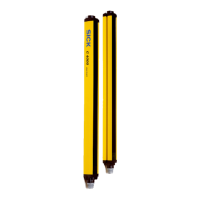Chapter 4 Operating Instructions
C 4000 Standard/Advanced
22 © SICK AG • Industrial Safety Systems • Germany • All rights reserved 8 009 861/OE59/19-11-04
Configurable functions
4.4 Bypass
In some applications it is, at times, necessary to mute the protective evaluation field of the
safety light curtain. This could be, e.g. in a safe machine set-up mode, in which the
machine can be operated only in jog mode. When the bypass is active, the safety light
curtain displays , Green and the 7-segment display of the receiver displays 3.
Switch on the machine safely when using the bypass function!
As long as the bypass function is active, the safety light curtain does not detect any
movements in the protective field. You must ensure that other protective measures are
activated during the bypass, e.g. the safe set-up mode of the machine in order that there
is no danger to persons or parts of the machine during the bypass.
The bypass function may only be activated by a key-operated switch with an automatic
reset and two levels or by two input signals that are independent of each other, e.g.
two position switches.
$ It must be possible to view the entire hazardous point when operating the key-operated
switch.
$ It is not possible to combine the bypass and PSDI mode functions.
$ 200 ms after switching off the bypass, the system is again in a safe status (latency time).
Device symbol C 4000 Host (receiver), context menu Configuration draft, Edit, selection of
the operating mode, General tab, option Bypass.
The connection of the key-operated switch for bypass is described in Section 6.8 "Key-
operated switch for bypass" on Page 54.
4.5 Output signal (ADO)
The C 4000 has a output signal (ADO) that can be configured. With the aid of the output
signal, the safety light curtain can signal specific states. You can use this output for a relay
or a PLC.
You must not use the output signal for safety-relevant functions!
You are only allowed to use the output signal for signalling. You must never use the output
signal for controlling the application or with safety-relevant functions.
Fig. 8: Schematic layout of
the bypass function
%
ATTENTION
Notes
!
%
WARNING
Bypass
inactive
Bypass
active
%

